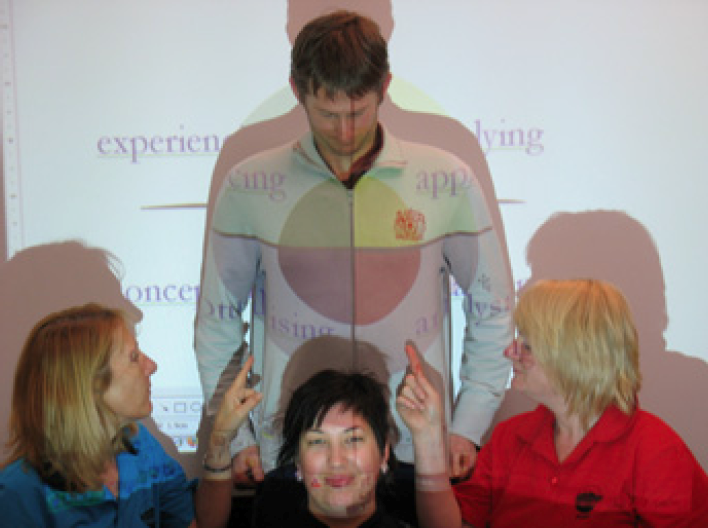
This case study describes the story of one teacher’s transformation through involvement in the Learning by Design project, funded by the Australian Research Council (ARC, 2005-08). It highlights that under the conditions of an experienced senior teacher (referred to as CF) with expertise in the use of inclusive methods and tools, supportive school leadership, a dynamic mentor, peer collaboration, and intensive workshops with ARC researchers over three years, to develop the teachers as researchers into their own practice, the intervention of Learning by Design, with its attendant knowledge processes, resulted in transformed teachers and students. …
In early 2006, in a Learning by Design workshop held in Canberra, a group of Royal Melbourne Institute of Technology (RMIT) University researchers, high school teachers and their mentors discussed the significance of the knowledge processes as outlined by pedagogical theorist Mary Kalantzis. The teachers discussed what the knowledge processes meant to them and in addition their significance for their practice. In particular, they discussed the what, the why and the how of class activities’ ‘fit’ with the knowledge processes. One experienced teacher, who was also part of the ARC project, linked her utilisation of the knowledge processes with the deeper understandings and metacognition of students concerning the purpose of their learning. This was arguably a significant moment in this group’s professional development as the teachers were confidently critical of their own practice and reflected on the implications and consequences of using the delineated knowledge processes or pedagogies in their classrooms.
Demonstrating a confident criticality, a product of working with the framework and the manifestation of a transformed teacher, CF picked up on the Learning by Design framework and argued that a teacher has to use all the knowledge processes:
What teachers do is the experiencing and the applying, but what we don’t do is the conceptualising and particularly the analysing and it’s from that you get your deeper thinking, reflections, understandings and intellectual rigour – that’s the whole point of Learning by Design. (Original emphasis)
Thus, at this early stage in the research project, CF was able to clearly identify and articulate the significance of the knowledge processes as crucial to her teaching practice, and the practice of others.
Like many of the teachers in the project, CF identified the ‘analysing critically’ knowledge process as being hitherto omitted in most teachers’ practice, but she also highlighted the knowledge processes of ‘conceptualising by naming’ and ‘conceptualising by theorising’ as being of crucial importance. A brief aside is necessary here to signal the pedagogical inclusivity of Learning by Design, i.e. its ability to harness both so-called traditional and progressive educational paradigms and to employ them not in terms of their binary oppositionality, but rather in terms of their complementarity and relationality. Thus, this form of teacher-centred ‘chalk and talk’ becomes, in the hands of CF, a productive pedagogical tool that weaves through the learning and supports analytical work, allowing the students to access deeper levels of understanding and knowledge. …
In an interview in 2007, CF reflected on how the Learning by Design heuristic had been critical to achieving the learning goals for all students:
The structure of my design contributed to the end product being so much better – they were really engaged. It’s an interesting subject for most students about Gallipoli and Anzac Day, but their depth of understanding was immense. Going on their excursion to the War Memorial, the experiential learning happened right at the beginning, whereas before, we would be going halfway through the topic, even at the end of the learning. It made it more purposeful as I had to think, ‘What’s going to be experiencing the new?’ We went to the War Memorial! We went the second day of term and all the way through we said, ‘Remember that at the War Memorial’, ‘Oh, I saw that at the War Memorial.’ That experiential learning consolidated a lot of things. When it came to writing the letter, because I had done all the scaffolding using the Learning by Design framework, they just sat down and wrote. They didn’t want to stop because they had so much they could write about. That was a definite ‘Ah ha’ moment for me, that occurred as a consequence of my design. The framework makes you start with experiential learning. It sets the tone and it came through all the activities that we did. …
Morgan, Leslie. 2010. “Teacher Professional Transformation Using Learning by Design: A Case Study.” E-Learning and Digital Media 7:280. | Link
